Envision Math Grade 8 Volume 1 Chapter 5 Analyze And Solve System Of Linear Equations
Page 257 Exercise 1 Answer
Given: Draw three pairs of lines, each showing a different way that two lines can intersect or not intersect.
How are these pairs of lines related?
There are n ways 2 lines can relate to each other.
The first way is that they are parallel, meaning they do not have any intersections.
The second way is if they are not parallel, but are not the same line. in this case, they have exactly 1 intersection.
The third and last way is, if the lines are the same, in this case, all of their points are the same.
That means they intersect at infinitely many points.
2 lines cannot have 2 points in common because 2 points clearly define a line.
That means if there is a line passing through both points, there cannot be another that does the same.
2 lines cannot have 2 points in common because 2 points clearly define a line.
If they have more than 1 point in common, it means they are the same line and have infinitely many common points.
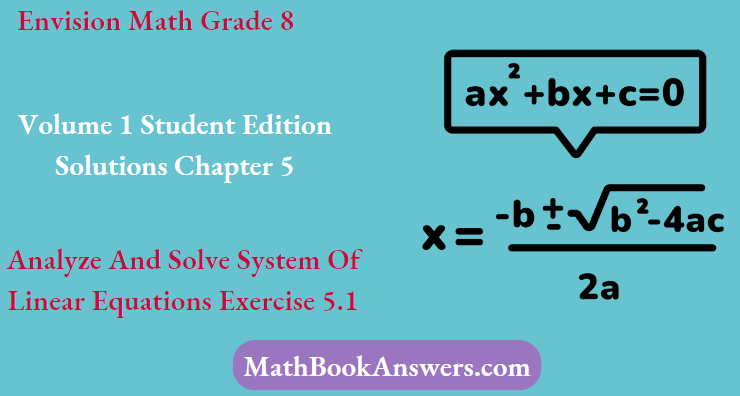
Envision Math Grade 8 Volume 1 Chapter 5.1 Solutions
Page 257 Focus On Math Practice Answer
To find: Look for Relationships is it possible for any of the pairs of lines drawn to have exactly two points in common?
Here we will see every relation between two lines and try to find the pairs of lines have exactly two points in common.
Here two lines are parallel means they have no common point,
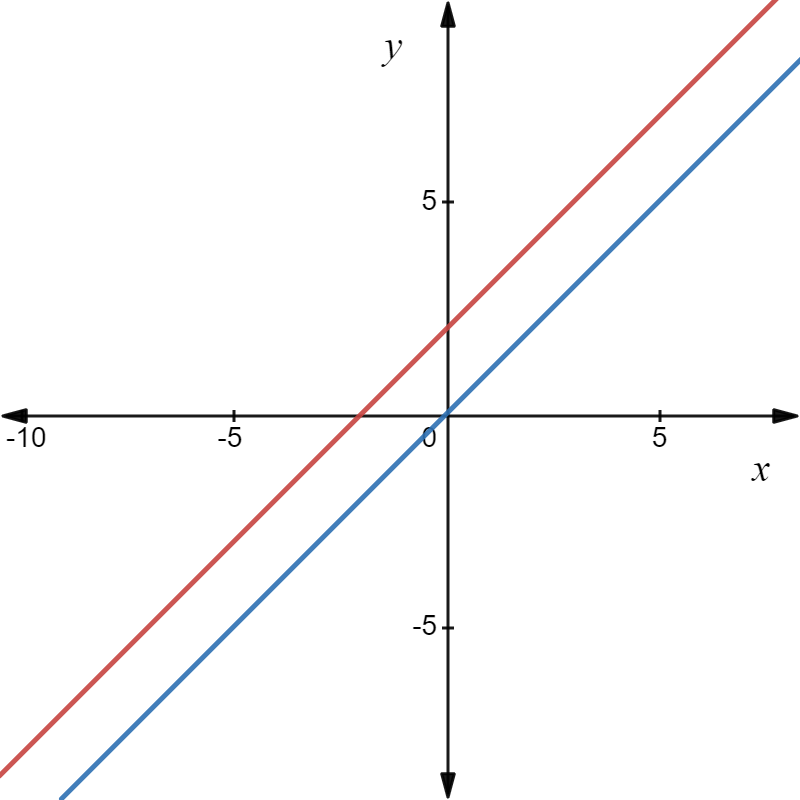
Here two lines intersects at one point means they have one common point,
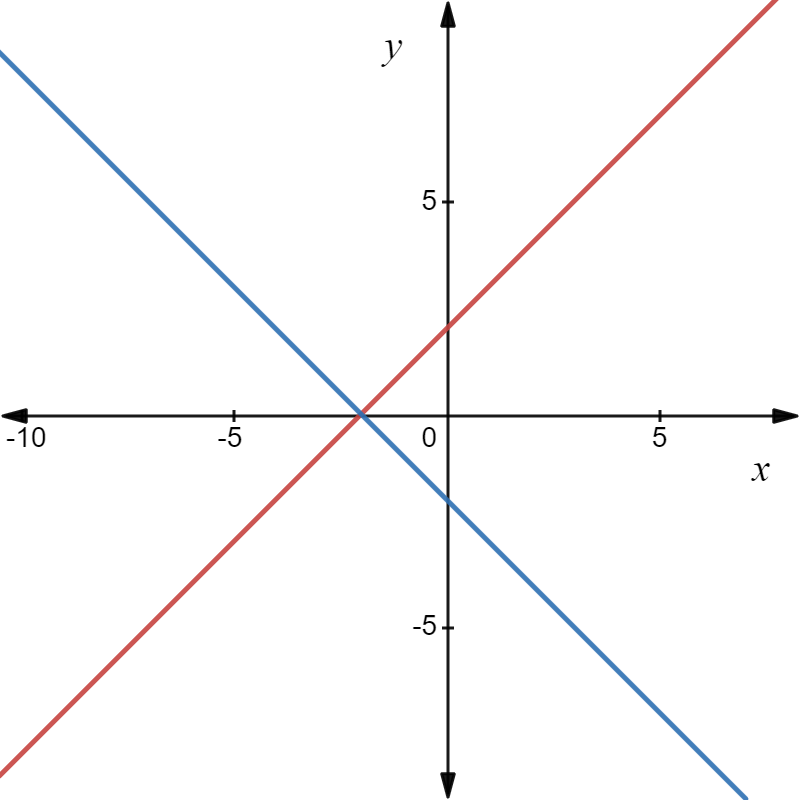
Here two lines are coincidental means they have infinite common points,
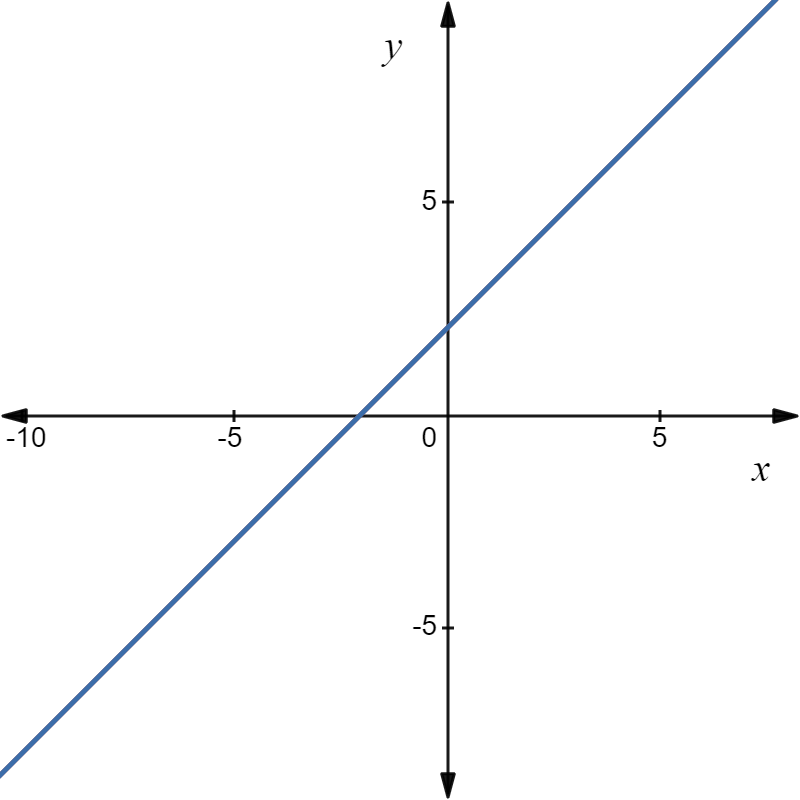
Here we see all possibilities like two lines have maximum infinite common points and minimum zero common points but that is not possible to have two common points.
Two lines can’t have exactly two common points.
Analyze And Solve Systems Of Linear Equations Envision Math Answers
Page 258 Essential Question Answer
If the two lines have different slopes, the system has exactly one solution (whether the lines have the same intercept or different intercepts).
If they have the same slope and the same intercept they are the same line, so there are infinitely many solutions to the system.
If they have the same slope and different intercepts then they are parallel and there is no solution to the system.
The slopes are different. The lines intersect at 1 point.
The slopes are the same, and the y-intercepts are different. The lines are parallel.
The slopes are the same, and the y-intercepts are the same. The lines are the same(coincident)
Page 258 Try It Answer
Given: y = x + 1, y = 2x + 2
To find: To explain how many solutions does this system of equation has.
y = x + 1
The first equation is written in slope-intercept form.
y = 2x + 2
The second equation is written in slope-intercept form.
y = 1x + 1
y = 2x + 2
Notice that the equations of the linear system have different slopes.
Since the equations have different slopes, the system has one solution.
The system of equations has one solution. The equations have different slopes, so lines intersect at one point.
Page 259 Try It Answer
Given:
y = −3x + 5
y = −3x − 5
To determine how many solutions does each system of equations has.
Here first we try to compare both equation’s slop and intercept.
Two lines equations:
y=−3x+5
…(1)
y=−3x−5
…(2)
Here we can see both lines slops are equal (m1 and m2 = −3) and y−intersects are different(c1 ≠ c2).
So lines are parallel and they have no solution.
The system of equations y = −3x + 5 and y = −3x − 5 have no solution.
Given: y = 3x + 4, 5y − 15x − 20 = 0
To determine how many solutions does each system of equations has.
y = 3x + 4
The first equation is written in slope-intercept form.
Rewrite the second equation in slope-intercept form:
5y − 15x − 20 = 0
5y − 15x − 20 = 0
Move the expression to the right
5y = 15x + 20
Divide both sides by 5
y = 3x + 4
Since both equations have the same slope-intercept form, they represent the same line.
Since both equations are the same, they intersect at every point, so the system has infinitely many solutions.
Envision Math Grade 8 Chapter 5.1 Explained
Big Ideas Math Algebra 1 Student Journal 1st Edition Chapter 5 Solving Systems Of Linear Equations Exercise Page 260 Exercise 1 Answer
To find: How are slopes and y-intercepts related to the number of solutions of a system of linear equations?
Deanna drew the pairs of lines below.
Each pair of lines represents a system of linear equations. A system of linear equations is formed by two or more linear equations that use the same variables.
you can use the graphs to determine the number of solutions for each system.
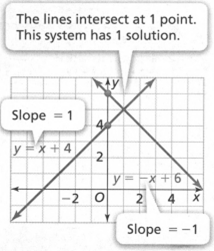
The equations of the linear system
y = x + 4
y = −x + 6
have different slopes.
The system has 1 solution(1,5).
A solution of a system of linear equations is an ordered pair that makes all equations in the system true.
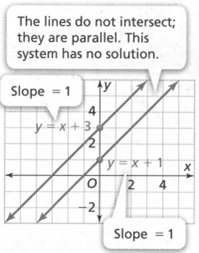
The equations of the linear system
y = x + 3
y = x + 1
have the same slopes and differenty−intercepts.
The system has no solution.
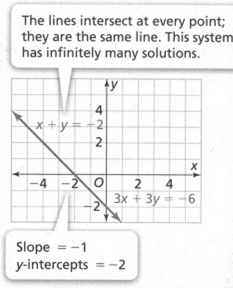
The equations of the linear system
x + y = −2
3x + 3y = −6
have the same slopes and the samey−intercepts. They represent the same line.
The system has infinitely many solutions.
Systems of equations can be solved by looking at their graphs.
A system with one solution has one point of intersection.
A system with no solution has no points of intersection.
A system with infinitely many solutions has infinite points of intersection.
Page 260 Exercise 2 Answer
Given:
3x + y − 2 = 0
5x + y − 2 = 0
To find: Construct Arguments Macy says that any time the equations in a system have the same y-intercept, the system has infinitely many solutions. Is Macy correct? Explain.
Convert the equation in a slope-intercept form then simplify the equation and find the slope and y-intercept.
Consider the following system of equations:
3x + y − 2 = 0
5x + y − 2 = 0
Now,
3x + y − 2 = 0
Write the equation in the slope-intercept form:
3x + y − 2 = 0
y = −3x + 2
Similarly, it follows that the slope-intercept form of 5x + y − 2 = 0 is:
5x + y − 2 = 0
y = -5x + 2
it is clear that the equations have the same y−intercepts viz. 2.
Solve the system of equations:
3x + y − 2 = 5x + y − 2 = 0
Rewrite the expression
{3x + y − 2 = 0
5x + y − 2 = 0
Move constants to the right
{3x + y = 2
5x + y = 2
Multiply both sides
{3x + y = 2
−5x − y = −2
Eliminate one variable by adding the equations
-2x = 0
Divide both sides
x = 0
Substitute the value of x
3 × 0 + y = 2
Solve the equation
y = 2
A possible solution is
(x,y) = (0,2)
Check the solution
3 × 0 + 2 − 2 = 5 × 0 + 2 − 2
= 0
Simplify
0 = 0
= 0
The ordered pair is a solution
(x,y) = (0,2)
It follows that the system has a unique solution.
Hence, Macy is not correct.
A system of equations has infintie solutions if the y-intercepts are equal and slopes are equal as well. Macy is incorrect.
Solutions For Envision Math Grade 8 Exercise 5.1
Big Ideas Math Algebra 1 Student Journal 1st Edition Chapter 5 Solving Systems Of Linear Equations Exercise Page 260 Exercise 5 Answer
a
\(y=\frac{1}{2} x+3\)Substitute \(\frac{1}{2} x=y\) into the equation to find the value of y:
y = y + 3
Subtract y from both sides of the equation:
y – y = y – y + 3
Calculate the differences:
0 = 0 + 3
Add the numbers:
0 = 3
Since the statement 0 = 3 is false, the system of linear equations has no solution.
The solution yields to 0 = 3 which is false, the system of equations has no solution.
Page 261 Exercise 7 Answer
convert the given equations in slope intercept form and then derive their sloped and y-intercepts individually. Further, compare them are make a conclusion.
7y = 13.3x – 56
Divide equation of rover B by 7 on both sides.
\(\frac{7 y}{7}=\frac{13.3}{7} x-\frac{56}{7}\)Simplify the equation.
\(\frac{7 y}{7}=\frac{13.3}{7} \times x-\frac{56}{7}\)Divide
Reduce
\(\frac{7 y}{7}=1.9 x-8\)Convert the expression
\(\frac{7 y}{7}=\frac{19}{10} x-8\)Multiply both sides
70y = 133x – 560
Divide both sides
\(y=\frac{19}{10} x-8\)Rover B: \(y=\frac{19}{10} x-8\)
Compare the equation of rover B with the slope-intercept form of the equation.
The slope obtained for the equation of rover B is mB = \(\frac{19}{10}\).
Convert mB to the decimal number.
mB = 1.9
The y-intercept obtained for the equation of rover B is bB = -8.
Rover A: y = 1.9x − 8
Similarly, compare the equation of rover A with the slope-intercept form of the equation.
The slope obtained for the equation of rover A is mA = 1.9.
The y−intercept obtained for the equation of rover A
is bA = −8.
Comparing mA and mB shows mA= mB
Comparing bA and bB shows bA = bB.
The system of equations has infinite solutions as slopes and y−intercepts are the same for both equations.
The slope for the rover A equation is equal to the slope for the rover B equation. The y−intercepts of the equations are −8. The system of equations has infinite solutions.
Big Ideas Math Algebra 1 Student Journal 1st Edition Chapter 5 Solving Systems Of Linear Equations Exercise Page 261 Exercise 8 Answer
Given:
y = x − 3
4x − 10y = 6
To find: How many solutions does this system have?
Convert the equation in a slope-intercept form then simplify the equation and find the slope and intercept.
y = x – 3
The first equation is written in slope-intercept form.
Rewrite the second equation in slope-intercept form:
4x − 10y = 6
Move the variable to the right
−10y = 6 − 4x
Change the signs
10y = -6 + 4x
Divide both sides
\(y=-\frac{3}{5}+\frac{2}{5} x\)Reorder the terms
\(y=\frac{2}{5} x-\frac{3}{5}\)y = 1x – 3
\(y=\frac{2}{5} x-\frac{3}{5}\)The equations of the linear system have different slopes.
The system has one solution.
Envision Math Grade 8 Volume 1 Chapter 5.1 Practice Problems
Page 261 Exercise 10 Answer
Given: −64x + 96y = 176
56x − 84y = −147
To find: What can you determine about the solution(s) of this system?
Convert the equation in a slope-intercept form then simplify the equation and find the slope and y-intercept.
Rewrite the first equation in slope-intercept form:
−64x + 96y = 176
Move the variable to the right
96y = 176 + 64x
Divide both sides
\(y=\frac{11}{6}+\frac{2}{3} x\)Reorder the terms
\(y=\frac{2}{3} x+\frac{11}{6}\)Rewrite the second equation in slope-intercept form:
56x − 84y = −147
Move the variable to the right
−84y = −147−56x
Change the signs
84y = 147 + 56x
Divide both sides
\(y=\frac{7}{4}+\frac{2}{3} x\)
Reorder the terms
\(y=\frac{2}{3} x+\frac{7}{4}\) \(y=\frac{2}{3} x+\frac{11}{6}\)
\(y=\frac{2}{3} x+\frac{7}{4}\)
The equations have equal slopes.
\(y=-\frac{4}{3} x+\frac{11}{6}\) \(y=-\frac{4}{3} x+\frac{1}{4}\)The equations have different y−intercepts.
Therefore, the graphs of the equations are parallel lines, so the system has no solution.
Equations have equal slopes, but different y−intercepts, so the system has no solution.
Big Ideas Math Algebra 1 Student Journal 1st Edition Chapter 5 Solving Systems Of Linear Equations Exercise Page 261 Exercise 11 Answer
Given:
y = 8x + 2
y = −8x + 2
To Find: Determine whether this system of equations has one solution, no solution, or infinitely many solutions.
Solve the system of equations then Eliminate one variable by adding the equations to find the ordered pair is a solution.
Solve the system of equations:
y = 8x + 2
y = −8x + 2
Simplify
−8x + y = 2
8x + y = 2
Eliminate one variable by adding the equations
2y = 4
Divide both sides
y = 2
Substitute the value of y
8x + 2 = 2
Solve the equation
x = 0
A possible solution is
(x,y)=(0,2)
Check the solution
2 = 8 × 0 + 2
2 = −8 × 0 + 2
Simplify
2 = 2
2 = 2
The ordered pair is a solution
One solution
The given system of equations has one solution.
Page 261 Exercise 12 Answer
Given:
2x + y = 14
2y + 4x = 14
To Find: Construct Arguments Maia says that the two lines in this system of linear equations are parallel. Is she correct? Explain.
Convert the equation in a slope-intercept form then simplify the equation and find the slope and y-intercept.
Rewrite the first equation in slope-intercept form:
2x + y = 14
Move the variable to the right
y = 14 − 2x
Reorder the terms
y = −2x + 14
Rewrite the second equation in slope-intercept form:
2y + 4x = 14
Move the variable to the right
2y = 14 − 4x
Divide both sides
y = 7 − 2x
Reorder the terms
y = −2x + 7
Now,
y = −2x + 14
y = −2x + 7
The equations have equal slopes.
y = −2x + 14
y = −2x + 7
The equations have different y−intercepts.
Therefore, the graphs of the equations are parallel lines.
Equations have equal slopes, but different y−intercepts, so the linear equations are parallel.
Maia is correct.
Page 261 Exercise 13 Answer
Given:
y = 2x + 10
y = x + 15
To find: Describe a situation that can be represented by using this system of equations. Inspect the system to determine the number of solutions and interpret the solution within the context of your situation.
Compare the equation with a slope-intercept form of the linear equation then According to the slope-intercept form make graphs and solve equations.
Let y and x be the total distance covered by a man in kilometres and the time taken to cover the distance in hours respectively.
Compare the equation y = 2x + 10 with a slope-intercept form of the linear equation:
m = 2,b = 10

According to the slope-intercept form, the y-intercept value is 10 means, at 0 hours the first person covered 10 kilometres.
To draw a line, calculate y for some values of x.
y = 2x + 10
Substitute the value of x = 1 in the equation:
y = 2(1) + 10
Solve for y:
y = 2 × 1 + 10
Calculation
y = 12
In the same manner, complete the table.
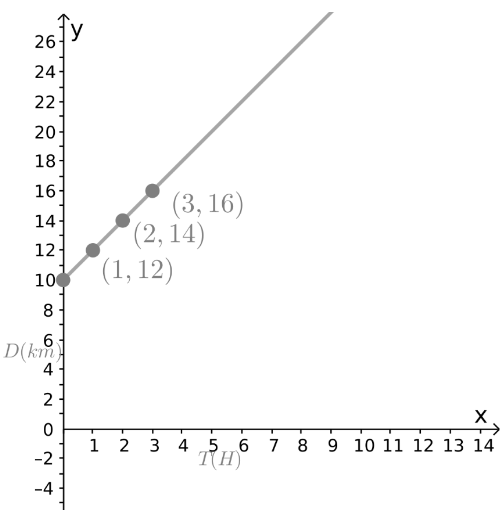
Plot the points (1,12),(2,14) and (3,16)
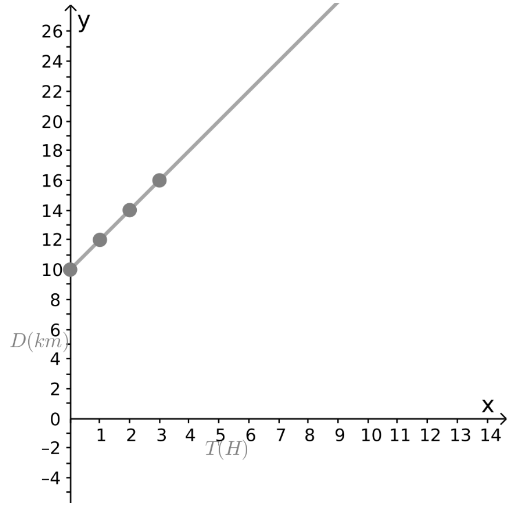
Draw a line through the points.
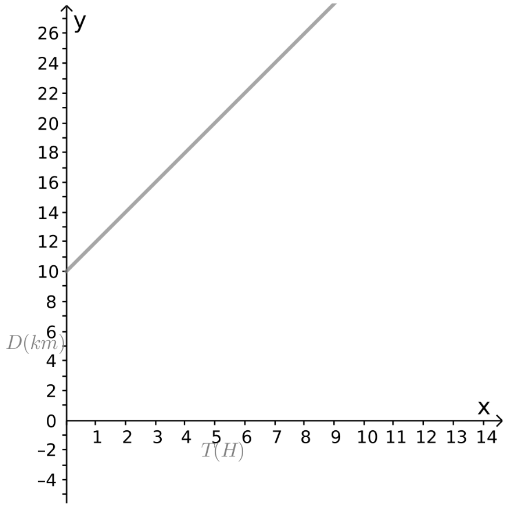
The line y = 2x + 10 shows the first person’s time-distance relation.
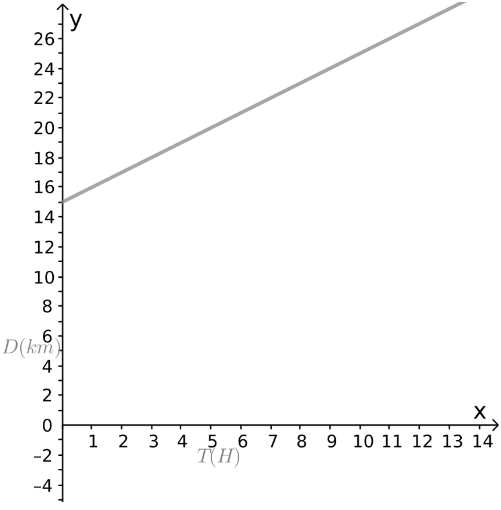
In the same manner, draw the line y = x + 15 that shows the second person’s time-distance relation.
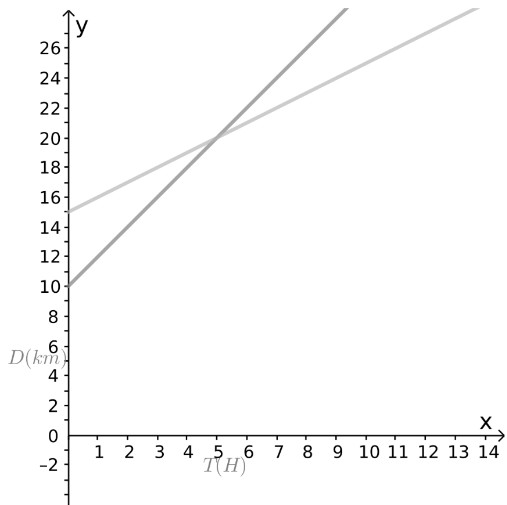
Draw the lines y = 2x + 10 and y = x + 15 in the same plane.
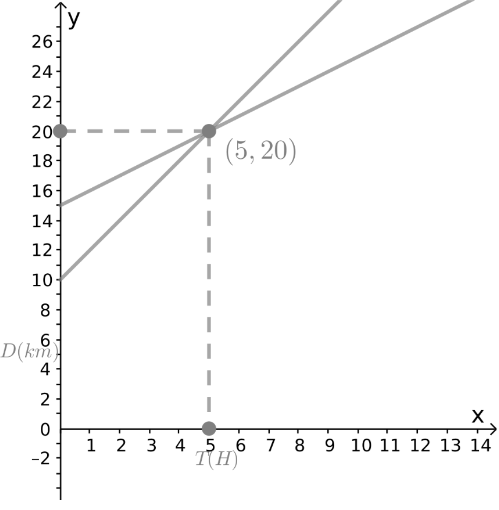
The two lines are meet at a point (5,20).
Since the lines are meet at one point, it has one solution.
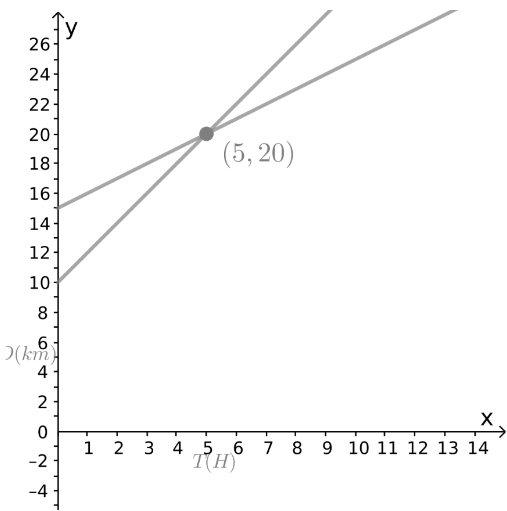
The system has one solution that is (5,20)
It represents two persons will meet at 20 kilometres distance after 5 hours.
Envision Math 8th Grade Systems Of Equations Topic 5.1 Key Concepts
Big Ideas Math Algebra 1 Student Journal 1st Edition Chapter 5 Solving Systems Of Linear Equations Exercise Page 262 Exercise 14 Answer
Given:
12x + 51y = 156
−8x − 34y = −104
To find: does this system has one solution, no solutions, or infinitely many solutions? Write another system of equations with the same number of solutions that uses the first equation only.
Simplify each equation in the system, observe both equations. If the equations in the system are multiples of common equations then it has infinitely many solutions.
Simplify each equation in the system.
Simplify the first equation:
12x + 51y = 156
Simplify
4x + 17y − 52 = 0
After simplification, the first equation is:
4x + 17y − 52 = 0
Simplify the second equation:
−8x − 34y = −104
Simplify
4x + 17y − 52 = 0
After simplification, the second equation is:
4x + 17y − 52 = 0
After simplification, both equations are equal.
If the equations in the system are multiples of common equations then it has infinitely many solutions.
Since the system has infinitely many solutions.
The common equation of the system is:
4x + 17y − 52 = 0
To find the second equation in another system, the common equation is multiplied by any number.
The equation 4x + 17y − 52 = 0 is multiplied by 4 on both sides: 4(4x + 17y − 52) = 4(0)
Any expression multiplied by 0 is 0 :
4(4x + 17y − 52) = 0
Multiply each term in the parentheses by 4 :
16x + 68y − 208 = 0
Add 208 on both sides of an expression:
16x + 68y − 208 + 208 = 0 + 208
Cancel the terms:
16x + 68y = 0 + 208
Simplify the right side of the equation:
16x + 68y = 208
Since the equations in the system are multiples of the common equations, the system has infinitely many solutions.
Another system of equations with infinitely many solutions is:
12x + 51y = 156
16x + 68y = 208
Envision Math Grade 8 Topic 5.1 Graphing Linear Systems Solutions
Page 262 Exercise 16 Answer
Given:
4x + 3y = 8
8x + 6y = 2
To find: the system has one solution, no solution, or an infinite number of solutions?
Convert the equation in a slope-intercept form then simplify the equation and find the slope and y-intercept.
Rewrite the first equation in slope-intercept form:
4x + 3y = 9
Move the variable to the right
3y = 9 – 4x
Divide both sides
\(y=3-\frac{4}{3} x\)Reorder the terms
\(y=-\frac{4}{3} x+3\)Rewrite the second equation in slope-intercept form:
8x + 6y = 2
Move the variable to the right
6y = 2 – 8x
Divide both sides
\(y=\frac{1}{3}-\frac{4}{3} x\)Reorder the terms
\(y=-\frac{4}{3} x+\frac{1}{3}\)\(y=-\frac{4}{3} x+9\) \(y=-\frac{4}{3} x+\frac{1}{3}\)
The equations have equal slopes.
\(y=-\frac{4}{3} x+9\) \(y=-\frac{4}{3} x+\frac{1}{3}\)
The equations have different y−intercepts.
Therefore, the graphs of the equations are parallel lines, so the system has no solution.
Equations have equal slopes, but different y−intercepts, so the system has no solution.
Envision Math Grade 8 Chapter 5.1 Lesson Breakdown
Big Ideas Math Algebra 1 Student Journal 1st Edition Chapter 5 Solving Systems Of Linear Equations Exercise Page 262 Exercise 17 Answer
Given: Qx + Ry = S and y = Tx + S
what circumstances does the system of equations have infinitely many solutions?
Solve the equations for ythen simplify the equation and find the slope and y−intercept.
Solve the first equation for y:
Qx + Ry = S
Move the expression to the right
Ry = S − Qx
Divide both sides
\(\mathrm{y}=\frac{\mathrm{S}-\mathrm{Qx}}{\mathrm{R}}\)Separate the fraction
\(y=\frac{-Q x}{R}+\frac{S}{R}\)Write as a product
\(\mathrm{y}=\frac{-\mathrm{Q}}{\mathrm{R}} \times \mathrm{x}+\frac{\mathrm{S}}{\mathrm{R}}\) \(y=-\frac{Q}{R} x+\frac{S}{R}\)The equation is now written in slope-intercept form.
For the system to have infinitely many solutions, the slopes of the lines and the y-intercepts must be equal.
\(\left\{\begin{array}{l}y=-\frac{Q}{R} x+\frac{S}{R} \\
y=T x+S
\end{array}\right.\)
The Slopes of the lines are \(-\frac{Q}{R} \text { and } T\).
\(\left\{\begin{array}{l}y=-\frac{Q}{R} x+\frac{S}{R} \\
y=T x+S
\end{array}\right.\)
The y-intercepts of the lines are \(\frac{S}{R} \text { and } S\).
\(\left\{\begin{array}{l}y=-\frac{Q}{R} x+\frac{S}{R} \\
y=T x+S
\end{array}\right.\)
The system has infinitely many solutions if:
\(-\frac{Q}{R}=T, \frac{S}{R}=S\)
Page 262 Exercise 19 Answer
\(\text { Given: }\left\{\begin{array}{l}y=\frac{2}{3} x+3 \\
y=\frac{5}{4} x+3
\end{array}\right.\)
Choose the statement that correctly describes how many solutions there are for this system of equations.
Solve the given systems of equations:
\(\left\{\begin{array}{l}y=\frac{2}{3} x+3 \\
y=\frac{5}{4} x+3
\end{array}\right.\)
Simplify
\(\left\{\begin{aligned}
-2 x+3 y & =9 \\
-5 x+4 y & =12
\end{aligned}\right.\)
Multiply both sides
\(\left\{\begin{array}{c}10 x-15 y=-45 \\
-10 x+8 y=24
\end{array}\right.\)
Eliminate one variable by adding the equations
−7y = −21
Divide both sides
y = 3
Substitute the value of $y$
−2x + 3 × 3 = 9
Solve the equation
x = 0
A possible solution is
(x,y) = (0,3)
Check the solution
\(\left\{\begin{array}{l}3=\frac{2}{3} \times 0+3 \\
3=\frac{5}{4} \times 0+3
\end{array}\right.\)
Simplify
\(\left\{\begin{array}{l}3=3 \\
3=3
\end{array}\right.\)
The ordered pair is a solution
One solution
\(\left\{\begin{array}{l}y=\frac{2}{3} x+3 \\
y=\frac{5}{4} x+3
\end{array}\right.\)
Notice that the slopes of the two equations are different.
Therefore the given system of equations has exactly one solution because the slopes are not equal.
The given system of equations has exactly one solution because the slopes are not equal because that options (A),(B) and (C) statements are incorrect.
Therefore, the correct option is (D) Exactly one solution because the slopes are not equal.
